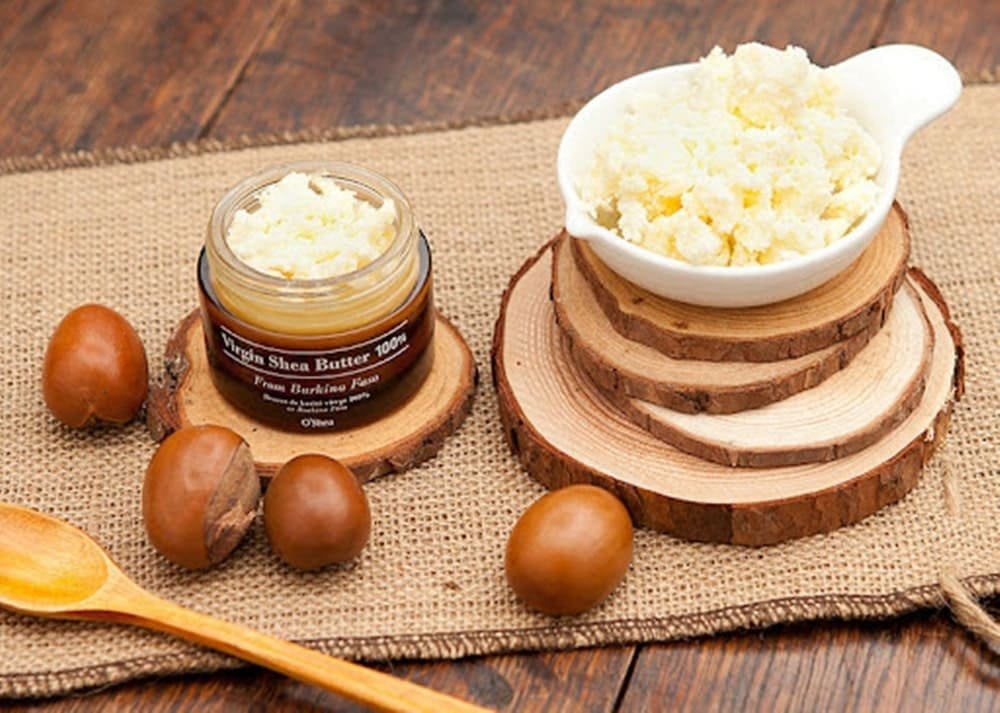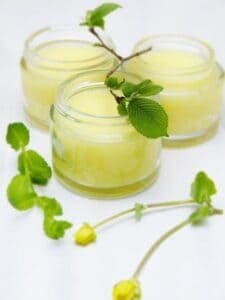
Shea butter benefits for skin and hair have recently acquired popularity, demonstrating that nature is still full of riches and wonders on a daily basis.
Its use in Africa has been known for thousands of years, although it has only recently become famous.
So please join me on a trip to discover the secrets of this butter, its uses, and its incredible advantages.
What exactly is shea butter?
Raw shea butter is extracted from the oils in the two kernels in the seeds of the shea tree, grown in the tropics of Africa.
There are two main types of shea tree:
- The first grows in East Africa.
- The second is in West Africa.
These two kernels are removed from the seed and ground.
Then, the powder is boiled in water until the layer of butter floats on the surface and is scraped.
Shea butter benefits for skin
Women are now using it for its moisturizing, anti-inflammatory, and anti-wrinkle benefits.
Moisturizing
In one study, researchers added 5% shea butter to skin cream and tested it on the hands of 10 female volunteers.
The volunteers noticed that the moisturizing effect remained on their skin for 8 hours.
Shea is rich in vitamins A and E and fatty acids like linoleic acid, necessary for hydration and wound healing.
Wrinkle resistance
Some studies have found that Amyrin, found in shea butter, plays a role in cell renewal and stimulating collagen production, which reduces the signs of aging.
Triterpene, an antioxidant, helps deposit collagen and stimulate skin cell division and growth.
Acne
According to a 2016 study, shea butter oil can be used as an antibacterial agent.
However, the study was met with opposition since adding shea-containing substances to the face, neck, back, and chest may lead to clogged pores and thus pimples.
Therefore, those who suffer from skin pimples should avoid using shea or other oily treatments containing shea on the face or any area prone to acne.
How to use shea butter for the face
It’s possible to use it as a face mask in the following manner:
Ingredients
Mix the following ingredients together:
- Two tablespoons of aloe vera gel.
- Two tablespoons of extra-virgin olive oil.
- With two tablespoons of shea butter.
N.B: If the butter is hard, warm it in the microwave for 10 seconds to melt.
Method
Please follow these steps:
- Clean the skin well and then dry it.
- Add the mixture to the face and neck.
- Leave it for 15 minutes or until it dries on the skin.
- Wash the face with warm water.
Why is Shea butter good for hair?
Shea butter has a strong moisturizing and softening effect on hair, especially for those with curly and dry hair, due to the fatty acids.
These acids provide luster to the hair and prevent it from heat damage caused by hair straighteners.
A recent study was also published on the amazing ability of shea to prevent hair breakage.
That is why we find it as an essential ingredient in most hair products, especially conditioners.
These products give hair strength, hydration, and softness.
Reducing scalp irritation
The anti-inflammatory properties of shea seeds help reduce scalp redness and irritation.
It also stimulates wound healing without clogging pores.
How do you apply shea butter to your hair?
You can mix shea butter with other hair-friendly ingredients.
It’s possible to use it as a hair mask in the following manner:
Ingredients
This method needs:
- An avocado fruit.
- 2-3 tablespoons of shea butter.
Method
Please follow these steps:
- Grind half an avocado until it becomes a paste.
- Warm the butter until it becomes oil.
- Mix the two ingredients together.
- Apply the mixture on the scalp to the ends of the hair, and leave it for 30 minutes.
- Wash the hair with warm water and your favorite shampoo.
You can repeat this process once or twice a week.
Therapeutic benefits of shea butter

Although it is commonly used on the skin to treat acne breakouts, burns, dryness, and dandruff, scientific evidence to support these uses has not yet been proven.
Hay Fever
Some studies reported that adding shea butter to the inner walls of the nose when necessary, for 4 days, helps relieve nasal congestion.
Using it this way cleared the airways and improved breathing in children and adults with hay fever.
Decongestant relief appears within 30 seconds of adding it to the nose, so researchers think it’s as effective as decongestant nasal sprays.
Eczema
Shea butter contains substances that reduce swelling, making it useful in eczema cases.
The researchers noted that adding it to the skin alone or with other substances helped reduce allergies in children and adolescents.
Anti-inflammatory
Amyrin also has anti-inflammatory properties, making the skin less sensitive to irritants.
Other uses
There are several other uses for shea, but they are still under research and study, including:
- Burns or scars.
- Dandruff and itching.
- Skin stretch marks.
- Psoriasis.
- Wound healing.
Tips before using shea butter
It is essential to make sure that you buy the original shea butter before using it.
It has several grades depending on the degree of refinement.
Raw, unrefined shea is the best kind to use.
It does not contain any chemicals or preservatives.
Shea is processed to remove the odor and make it white.
However, this causes it to lose about 75 percent of its beneficial components.
Also, make sure to use the appropriate density on the hair strand, as follows:
- If the hair is thin or oily, it is not preferable to use the butter.
- If the hair is flexible and light, use shea oil, not butter.
It is also worth noting that it has a distinct nutty or hazelnut-like smell, but added aromatic scents can mask it.
Shea butter side effects
It is generally safe because some people use it as a fatty substance added to foods.
There is also no evidence that taking it in significant quantities as a medicine causes harm.
It is considered safe when used on the skin for up to 4 weeks, and there have been no reports of side effects with longer use.
In addition, it is safe on the scalp and for all hair types, including dry and dyed hair.
Precautions for use during pregnancy and lactation
Shea butter in the natural quantities found in food is safe for pregnant and breastfeeding women.
However, it is necessary to be careful when taking it orally in high doses.
Storing shea butter
Shea tree butter can be stored at room temperature.
If the temperature is a little high, it will turn into an oily form.
It also turns oily as soon as you massage it on the skin, facilitating absorption.
Keep it at a steady temperature because exposure to different temperatures causes a change in its nature.
Finally, recourse to nature and its treasures is still the safest and easiest way during our journey in search of lasting beauty.
However, contact your doctor immediately if an unexpected reaction occurs on the skin or scalp after using shea butter.
Read Also;
Lumigan drops | The magical secret for long lashes
Dark eye circles| causes and treatment for adults and children